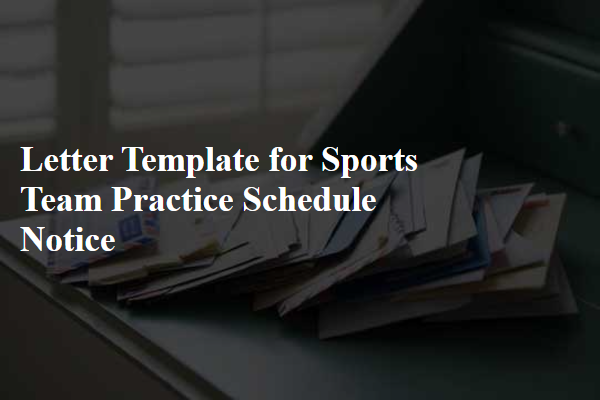In the world of sports, unexpected situations can arise, making it crucial for teams to have a well-structured emergency protocol in place. Whether it's a sudden injury or an unforeseen weather event, being prepared can mean the difference between chaos and a coordinated response. This article will guide you through essential elements of an effective emergency protocol tailored specifically for sports teams. Ready to equip your team with the knowledge to handle any emergency? Keep reading!

Contact Information
A comprehensive sports team emergency protocol should include essential contact information for key personnel and local emergency services. This protocol typically features the coach's name and their mobile number, ensuring prompt communication during emergencies, and the athletic trainer's contact information, crucial for immediate medical assessment. Additionally, it encompasses emergency contacts for each player, often listing parents or guardians with their phone numbers, located in a clearly organized manner. Local emergency services, such as the nearest hospital, fire department, and police station, should be included with addresses and direct phone lines to guarantee swift assistance when needed. Furthermore, consider incorporating the local poison control center and mental health crisis hotline for more varied emergencies, ensuring a comprehensive support system for all team members during events.
Emergency Action Plan Summary
An Emergency Action Plan (EAP) for sports teams outlines protocols to ensure safety during medical emergencies at events. It includes essential details such as immediate response steps, contact numbers for local emergency services (e.g., 911 in the United States), and specific medical personnel on-site, such as certified athletic trainers or paramedics. Designated locations for emergency supplies, like automated external defibrillators (AEDs) and first aid kits, should be clearly identified, typically near the playing field or court. The plan also specifies communication strategies with team members and spectators regarding safety procedures. Regular drills and training sessions are fundamental to ensure that all personnel are familiar with protocols, enhancing efficiency during real emergencies. Establishing an effective EAP can significantly impact the outcomes of medical incidents, ensuring swift and organized responses.
Roles and Responsibilities
Emergency protocols for sports teams ensure the safety and well-being of athletes during critical situations. Each member of the team has specific roles and responsibilities. The Team Physician, responsible for immediate medical evaluation, must assess injuries quickly, while the Certified Athletic Trainer handles first aid. The Head Coach oversees the situation, coordinating communication with emergency services if necessary. Team Captains provide leadership and ensure athletes remain calm. Parents or guardians, when present, should be informed of any emergencies and their roles in supporting athletes. Communication systems, such as two-way radios or mobile phones, are essential for coordinating efforts effectively during an emergency at venues like stadiums, practice fields, or arenas. Regular drills at least once a season help ensure everyone understands their responsibilities.
Communication Protocols
Establishing effective communication protocols during emergencies is essential for sports teams to ensure player safety and coordination. A dedicated communication system, such as a two-way radio network or messaging app, should be implemented, allowing immediate alerts to coaches (leadership figures responsible for team direction) and medical personnel (trained professionals equipped to handle injuries and emergencies). An emergency hotline number, readily accessible to all team members and staff, can facilitate prompt reporting of incidents. Regular training sessions (scheduled events that reinforce protocols and responsiveness) should occur to familiarize the team with procedures and roles during emergencies. Designated roles, such as a Safety Officer (responsible for monitoring safety and health protocols), should be assigned to manage the situation effectively. Finally, debriefing sessions (meetings held after incidents to evaluate responses) should take place to analyze the effectiveness of the communication protocols, ensuring continuous improvement in handling emergencies.
Review and Training Procedures
Emergency protocols for sports teams focus on critical response strategies during unforeseen events such as injuries or natural disasters. Regular training sessions are essential for all team members, including coaches, medical staff, and athletes, to ensure familiarity with procedures. The protocol covers key aspects such as first aid techniques, communication channels (designated individuals responsible for emergency notifications), and emergency contact information (local emergency services like 911). Additionally, specific drills (like evacuation and injury response) should be scheduled annually to maintain readiness. Documentation (like participant acknowledgment forms) ensures that all team members understand procedures, fostering a safe sporting environment. Proper preparation can significantly mitigate risks associated with on-field emergencies.













Comments